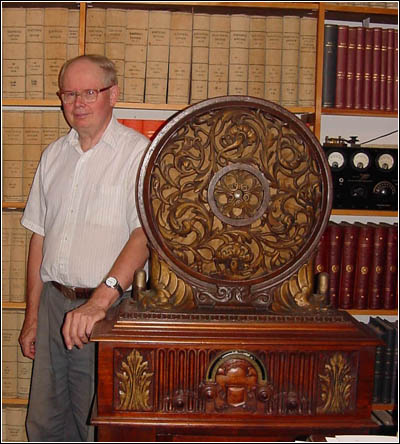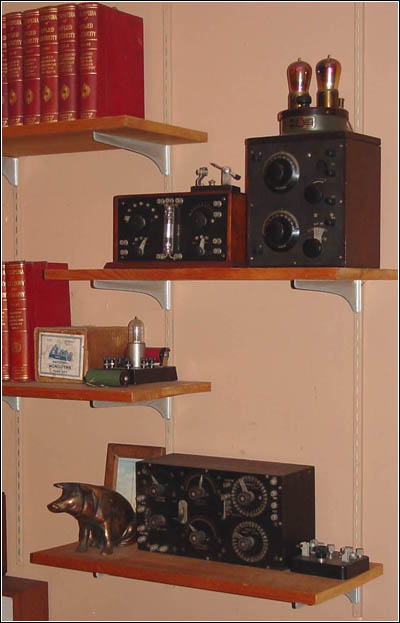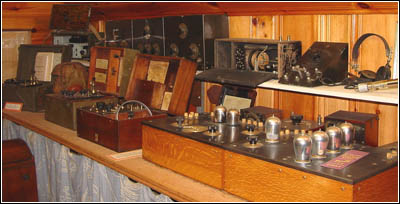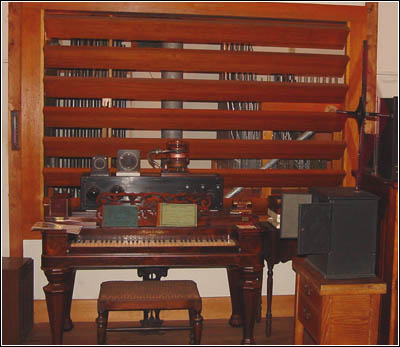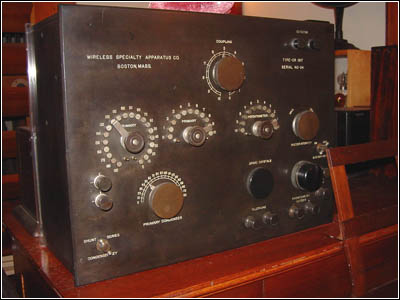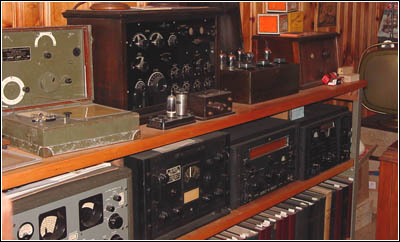Of Old Radios And Related Items--Published Monthly
A Visit to the Alan Douglas Museum
BY DAVE CROCKER
WEB EDITION
When collections become too large for homes, the next step is to find space elsewhere, and sometimes that space becomes a "Museum." Here's the story of the impressive Alan Douglas museum. Alan is a historian who is quick to share his knowledge with fellow collectors. We are pleased that Dave Crocker has compiled this tour through Alan's museum for us. (Editor)
Passing by the house in Pocasset on Cape Cod, you would never guess what treasures lie inside the walls. It's just a quiet, rural neighborhood, and the house is a standard white Victorian with a porch and a barn out back that looks like nothing special. Not the exterior, anyway!
But, this is the residence of Alan Douglas, known for his three-volume set of books Radio Manufacturers of the 1920's. We all know them and refer to them constantly. He is also the author of another book on test equipment called Tube Testers & Classic Electronic Test Gear. Alan is well known and respected in the AWA and most other radio circles. He was one of the first radio collectors I met when I started collecting.
This house and barn hold a wealth of historic and antique radios, many of which are pictured in his three-volume set of books. If Alan has it on display, it has been carefully selected, and it is in fantastic original condition.
Figure 1. Alan beside his DeForest W6 "Renaissance" console in his library.The House
First the house. On the first floor rear, is Alan's library. It is pictured on the back of Alan's book, Volumes 1 and 2. In this library is everything you ever wanted to know about the history of radio, but were afraid to ask. Volumes and volumes of books and reference material are on the shelves along side of some truly rare radio items. Figure 1 shows Alan next to his DeForest Renaissance backed by some of the books in his library. Step carefully, as scattered on the floor are open books, radio advertising pieces, rare tubes, and projects in progress.
Most of the radios here are vintage wireless and battery sets. If there is a plug-in set, you can be sure it's a first in AC receivers. You will also notice what looks like a Marconi Multiple Tuner sitting atop a pristine Atwater Kent Model 812 console, all shown in Figure 2 (see print version). Alan built the Marconi years ago from plans in a 1915 issue of Scientific American.
Look some more and you'll see a rare Western Electric 3B receiver. And over there is an ultra rare DeForest W6 "Renaissance" console -- and, amazingly enough, the actual Zenith radio that Commander Donald B. MacMillan took aboard his ship the Bowdoin on his historic 1925 Arctic expedition!
We won't go there, but down cellar is where I always end up when visiting Alan. When I get into trouble restoring a radio, I know I can depend on Alan to find the right part in his cellar, which is absolutely filled with -- everything! -- including manufacturers' literature and catalogs.
Upstairs, there are bedrooms with displays of things like a Clapp-Eastham RHM, a bright red Crosley Showchest, and a Flex-o-Dyne. These sets are shown in Figure 3 (see print version). This latter set was manufactured by Charles G. Hall of New York City in the mid-1920s and used Telos Vario-Transformers (the same as in the more common Melco Supreme set). The bottom drawer still has the original batteries.
Figure 4. Another upstairs room reveals a World War I NESCO CN-112 submarine receiver on the bottom shelf. Above and to the left is a National Airphone Monodyne. On the upper right shelf is an Audiotron control box, possibly by Remler, and to its right, a Radak HR with an Atwater Kent TA unit on top.
Figure 5. The Liberty BC14A receiver with attached aviator's helmet can be seen in the bottom row far left. To its right is a BC14 receiver, and next, a French Type A receiver. Prominent in the foreground is the two-piece Westinghouse rebroadcast receiver. Top row, on the left is the 3-piece GE AR1300, AR1520 and AA1400 receiver combination. Next is a crystal set made for Sears Roebuck by American Marconi, which includes a loose-coupler and a tubular tuning condenser, and next a GE ER753 crystal set with headphones.Alan, having an interest in any British set with U.S. connections, has a British Birmingham Small Arms (BSA) set on top of his Crosley Showchest, also shown in Figure 3 (see print version). BSA is better known for motorcycles and made a short foray into wireless in the mid-1920s using parts and circuitry from Western Electric (or Standard Telephones & Cables, STC, as it was known then). This set uses three peanut tubes (Wecovalves) and a Type 101.
To mention just a few more, a NESCO CN-112 submarine receiver, a National Airphone Monodyne, and an Atwater Kent TA amplifier connected to a Radak HR (sold that way), are shown in Figure 4. A back bedroom displays a couple of consoles and four ship cone speakers, such as a Na-Ald, Vitalitone, and two Tower speakers.
Around the corner is a room jammed with incredibly rare pieces. You can barely walk as the radios are everywhere. Early radios of the teens, dealer display signs, old TVs, Ham receivers and, yes, more radio literature.
As Figure 5 shows, on a shelf is an original Liberty BC14A airplane crystal set, along with an aviator's helmet and phones. Looking around you have to take your time because I guarantee you'll miss a lot.
Figure 7. In the rear is the swell box for the Aeolian-Skinner player pipe organ; in front is the Mason & Hamlin melodeon; and at far right, a DeForest D-10. The long radio above the keyboard is a 1924, home-brew Receptrad superhet.The Barn
Now, the barn! Alan began digging a foundation beside the original barn in 1970. Figure 6 (see print version) shows the barn and the addition. It was here he was to develop his "Museum." Now you pass through the big barn door and past a room filled with (what Alan calls) "ordinary stuff." Not so, as there are some fantastic pieces stored on those shelves, all awaiting space to be displayed -- someday.
Into the main room of the barn, heated incidentally by solar, is a mind-boggling array of items, all of which are in perfect working order. Prominent is the gigantic 1936 Aeolian-Skinner Opus 947 player pipe organ keyboard and swell box. The front of the swell box is seen in Figure 7, and it is comprised of horizontal slats that open and close to act as a dampener to this organ.
Originally installed in the home of a Woolworth heiress, the Aeolian-Skinner organ consists of two manuals and seven ranks and can operate on paper music rolls. If the weather is warm enough, Alan will be happy to play the Aeolian-Skinner with music rolls. The sound is incredible! The organ keyboard is seen in Figure 8 (see print version).
Sitting on top of the Aeolian- Skinner keyboard is a rare Wireless Specialty Apparatus CR 1917, made in 1918. Close-up views of the panel and the inside rear of the set are shown in Figures 9 and 10 (see print version).
Alan's collection also includes several interesting communications receivers. Two Millen sets, a DFP 201 and a DFP 501, were to be Millen's post-war receiver line, but only a couple of 201 prototypes were made, along with the single 501, for exhibition in Chicago in 1947. An E.H. Scott RCH, which was primarily used by the Merchant Marine, covers both long-wave and shortwave bands. These sets are shown in Figure 11.
Another item is a Federal 61, which Alan had wanted since 1960, and he ultimately bought it at an Antique Radio Club of America meet. It is hard to believe that, as Alan says, each of the 18 knobs has a definite function.
A very "uncollectible" set sitting on the same shelf as the Federal 61 is a Phanstiehl "one-eyed" set, which Alan appreciated only after he realized how beautiful the cabinet work is. A close-up view of this set can be seen on page 225 of Alan's Volume 2 of Radio Manufacturers of the 1920's.
Figure 9. Panel view of the Wireless Specialty Apparatus CR 1917.Alan also has the first U.S.-made AC set -- a Dynamotive Radio Corp. Dynergy RC250. This set, shown in Figure 11, was manufactured in 1924 and was powered by 110VDC. A separate power pack converted the 110VAC to DC. A close-up of this set can be seen on Page XV of Volume 1 of Radio Manufacturers of the 1920's. Of course, many other sets from Alan's collection and other collections are detailed in this 3-volume series.
This main room also contains the lighted tube display shown in Figure 12 (see print version). Above it is the first radio Alan got as a collector while in his teens -- his grandparents' Atwater Kent Model 20C. Below the tube display is a mirror galvanometer used to test cables during the construction of the Boston Street Railway in 1910, and an early New Way 1-cylinder engine.
This room is special to me, as whenever I come here, I can still see the very first radio I acquired in 1969 -- a 1929 Ampico console radio, the very radio that started me on collecting antique radios. I hope Alan never lets it go.
Figure 11. Left to right, top, a BC148, a Federal Model 61, a Dynergy AC set, and a Pfanstiehl receiver; Left to right, bottom, a Hammarlund SP-600, a Scott RCH, a Millen DFP 201 and a Millen DFP 501; far right, a Philco Predicta TV -- quite a variety of items.A few other items in the collection, such as a 1907 Seeburg Nickelodeon, are shown in Figure 13 (see print version). There's a lot more to see, but I can't mention everything -- there's just too much!
Among the many, many items is my favorite -- a Curtis & Crocker brass-bladed fan run on 110VDC. (I've got first dibs!). It is shown in Figure 14 (see print version).
Unfortunately, if you go to Alan's museum, you've already missed the 1968 Chevvy that is shown on the back cover of his Volume 3. The car is long since gone, and, sadly enough, the old pickup is off the road.
If you decide to visit, Alan will personally guide you on a tour. However, visits have to be set up ahead of time, as Alan still works full-time. He's a very busy person, and says he doesn't have time to get to all the projects he's planned. Best advice is to e-mail him for a visit at adouglas@gis.net.
Reference:
Douglas, Alan. Radio Manufacturers of the 1920's, Vols. 1, 2, 3. Chandler, AZ: Sonoran Publishing, 1988, 1989, 1991.
(Dave Crocker, 35 Santuit Pond Rd., #4B, Mashpee, MA 02649)
Dave Crocker, a graphic artist and a semi-retired member of the A.R.C. staff, has been collecting radios for over 30 years. Many of those years have been spent researching and collecting radios made by the Crosley Radio Company.
| [Free Sample] [Books, etc., For Sale] [Subscribe to A.R.C./Renew] [Classified Ads] [Auction Prices] [Event Calendar] [Links] [Home] [Issue Archives] [Book Reviews] [Subscription Information] [A.R.C. FAQ] URL = http://www.antiqueradio.com/May07_Crocker_Museum.html Copyright © 1996-2007 by John V. Terrey - For personal use only. Last revised: May 2, 2007. For Customer Assistance please contact ARC@antiqueradio.com or call (866) 371-0512 toll free Pages designed/maintained by Wayward Fluffy Publications
Antique Radio Classified |
